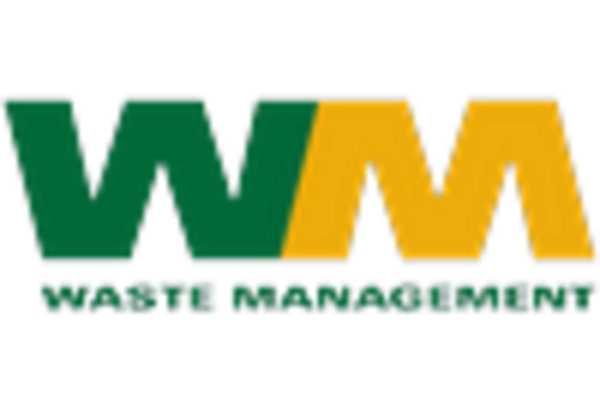Increasing Urbanization
The rapid pace of urbanization is a pivotal driver for the Waste Disposal Equipment Market. As populations in urban areas continue to swell, the demand for efficient waste management solutions escalates. Urban centers are generating more waste than ever, necessitating advanced disposal equipment to handle the increasing volumes. According to recent estimates, urban areas are projected to account for over 70% of the global waste generation by 2025. This trend compels municipalities and private sectors to invest in modern waste disposal technologies, thereby propelling the Waste Disposal Equipment Market forward. Furthermore, the need for effective waste segregation and recycling in densely populated regions underscores the importance of innovative disposal equipment, which can streamline operations and enhance sustainability efforts.
Technological Innovations
Technological advancements are reshaping the Waste Disposal Equipment Market, introducing new efficiencies and capabilities. Innovations such as smart waste management systems, automated sorting technologies, and advanced compaction solutions are becoming increasingly prevalent. These technologies enhance operational efficiency and reduce labor costs, making waste disposal processes more effective. For instance, the integration of IoT in waste management allows for real-time monitoring and data analytics, optimizing collection routes and schedules. Market projections suggest that the adoption of such technologies could lead to a significant reduction in operational costs for waste management companies. As these innovations continue to evolve, they are likely to drive further investment in the Waste Disposal Equipment Market, as stakeholders seek to leverage technology for improved waste management outcomes.
Rising Environmental Awareness
Growing environmental consciousness among consumers and businesses is significantly influencing the Waste Disposal Equipment Market. As awareness of the detrimental effects of improper waste disposal increases, there is a marked shift towards sustainable waste management practices. This shift is reflected in the rising demand for equipment that supports recycling and waste-to-energy initiatives. Market data indicates that the recycling equipment segment is expected to witness substantial growth, driven by both regulatory pressures and consumer preferences for eco-friendly solutions. Companies are increasingly adopting waste disposal technologies that minimize environmental impact, which in turn fosters innovation within the Waste Disposal Equipment Market. This trend not only aligns with corporate social responsibility goals but also meets the expectations of environmentally conscious consumers.
Government Regulations and Policies
Stringent government regulations and policies regarding waste management are a crucial driver for the Waste Disposal Equipment Market. Governments worldwide are implementing stricter guidelines to ensure proper waste disposal and promote recycling initiatives. These regulations often mandate the use of specific types of waste disposal equipment, thereby creating a robust market for compliant technologies. For example, many regions have established targets for waste diversion from landfills, which necessitates the adoption of advanced recycling and composting equipment. The enforcement of these regulations not only compels businesses to upgrade their waste disposal systems but also stimulates innovation within the Waste Disposal Equipment Market. As compliance becomes increasingly critical, the demand for reliable and efficient waste disposal solutions is expected to rise.
Economic Growth and Industrialization
Economic growth and industrialization are driving forces behind the expansion of the Waste Disposal Equipment Market. As economies develop, industrial activities increase, leading to higher waste generation across various sectors. This trend is particularly evident in emerging markets, where rapid industrialization is accompanied by a surge in waste production. Market analysis indicates that the industrial waste segment is expected to grow significantly, necessitating specialized disposal equipment to manage diverse waste streams. Additionally, as businesses expand, the need for efficient waste management solutions becomes paramount to maintain operational efficiency and comply with environmental standards. Consequently, the Waste Disposal Equipment Market is likely to experience sustained growth as industries seek to invest in advanced waste disposal technologies to address their increasing waste management challenges.


















Leave a Comment